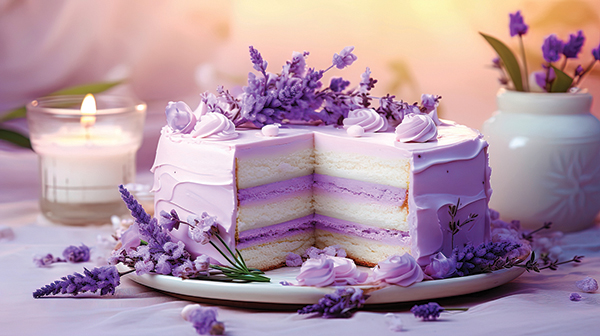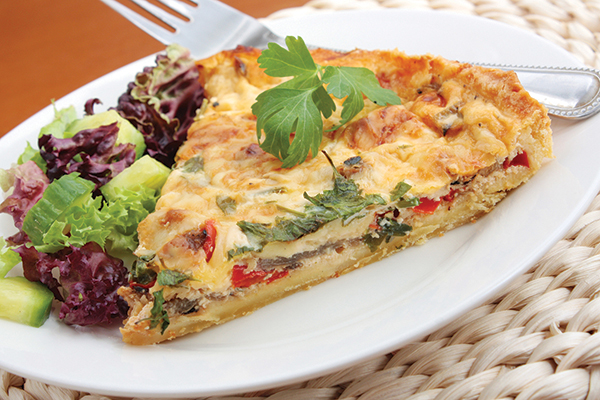Lemon Lavender Cake
Lavender is an enchanting but often overlooked ingredient in the kitchen. When used well, it provides a delicate floral note with hints of mint or rosemary, creating a unique taste. Be careful to use it sparingly to avoid overwhelming a dish with soapy flavor.

CAKE
- 3 cups all-purpose flour
- 2 1/2 tsp baking powder
- 1/2 tsp baking soda
- 1/2 tsp kosher salt
- 2 cups sugar
- 2 tbsp lemon zest (from about 4 lemons)
- 1 tbsp dried culinary lavender
- 1/2 c unsalted butter, room temp
- 1/2 cup vegetable oil
- 4 large eggs, room temperature
- 1 tsp vanilla extract
- 1/3 cup fresh lemon juice
- 1 cup whole milk
FROSTING
- 1 1/2 cup (3 sticks) unsalted butter, room temperature
- 6 cups powdered sugar
- 1/3 cup whole milk
- 1 tbsp lemon extract
Preheat oven to 350°F.
Grease two (8-inch) round cake pans with butter. Line pans with parchment paper, then grease and dust parchment with flour. In medium bowl, whisk flour, baking powder, baking soda, and salt.
In food processor bowl, add sugar, lemon zest, and dried lavender. Process sugar mixture 1-3 minutes until lavender is finely ground and zest and lavender are distributed throughout the sugar. Beat butter, vegetable oil, and lemon-lavender sugar on medium-high until very pale and fluffy, about 4 minutes. Mixture volume should double or nearly triple.
Add eggs, one at a time, beating until fully combined after each addition. Scrape bottom and sides of bowl with a rubber spatula. Stir in vanilla extract. Add half the flour mixture into butter mixture and mix on low until incorporated. Pour in milk and lemon juice and continue mixing on low until combined.
Add remaining flour mixture and mix on low just until incorporated. Use rubber spatula to scrape bowl between additions to ensure even mixing. Divide batter evenly between two prepared cake pans. Bake 30 to 35 minutes, or until a toothpick inserted in the center of the cake comes out clean. Edges of cake will have begun to pull away from the sides of the pan, and center should spring back when gently poked with a finger.
Let cakes cool in pans for 15 minutes, then turn out onto a wire rack to cool completely before frosting.
To Make Frosting
In a stand mixer fitted with the paddle attachment, or in a large mixing bowl with a hand mixer, beat butter on medium speed until smooth and satiny, about 2 minutes.
Add powdered sugar, half of the milk, and lemon extract and continue beating on medium speed until light and fluffy, about 2 minutes. If too thick, add more milk, 1 tablespoon at a time, until it reaches the desired consistency.
Place one of the cake layers right-side-up on a large plate or a 10-inch cardboard cake round. Use an offset spatula or a butter knife to spread a thick layer of frosting, 1/2 to 1 cup, evenly over the layer.
Top with the remaining cake layer, placed upside down, so the top of the cake is smooth and flat. Check that the cake layers are centered and that the top of the cake is level. Gently adjust accordingly.
Spread a generous amount of frosting over the top and sides of the cake using an offset spatula or the straight edge of a large butter knife. Use spatula to spread the frosting into a thin, even layer. You should be able to see the cake through the frosting.
This thin layer of frosting is called the crumb coat and helps catch any loose crumbs on the outside of the cake so the final layer of frosting has no crumbs caught in it.
Place the cake in the refrigerator for 20 minutes for the frosting to set. Cover the bowl of frosting.
Remove cake from the refrigerator. Stir the frosting a few times to smooth it out again.
Spread a generous amount of frosting over the top and sides of the cake as before, this time leaving a thicker layer of frosting. Use the offset spatula, a large spoon, or the back of a butter knife to smooth the sides.
MIMOSA BAR
Select Your Bubbles
Offer a range of sparkling wines to cater to different tastes. Include traditional options like Champagne or Prosecco, and consider adding a domestic sparkling wine for variety.
Non-Alcoholic Options: For those who prefer non-alcoholic beverages, include sparkling water or non-alcoholic sparkling wine.
Choose Your Juices
Orange juice is a must, but don’t stop there. Offer peach, pomegranate, grapefruit, and cranberry juices for colorful and tasty options.
Freshness Counts: Opt for high-quality, freshly squeezed juices, if possible, for a noticeable difference in flavor.
Prepare The Garnishes
Slice fresh fruits like strawberries, raspberries, blueberries, and orange slices. Not only do they add flavor, but they also make the drinks visually appealing.
Herbal Touches: Offer fresh herbs such as mint or basil for an aromatic twist.
Set Up The Bar
Use clear pitchers or carafes for the juices and bowls for the fruits and herbs to create an elegant display.
Glassware Matters: Have an ample supply of flutes or glasses available, ensuring everyone can partake.
Label Everything: Use labels or small signs to identify the different juices, wines, and garnishes. This helps guests create their perfect mix without guessing.
Keep Things Chill
Ensure all beverages are well-chilled before serving. Use ice buckets for the wines and keep juices in the refrigerator until just before serving.
Ice on the Side: Have a bucket of ice on the side for guests who prefer their mimosa extra cold.
Enjoy Responsibly
Ensure there are plenty of non-alcoholic options available for those who prefer them or are driving.
Hydration Station: Set up a water station with still and sparkling water to keep guests hydrated throughout the celebration.
SPRING VEGETABLE FRITTATA

Frittatas are versatile, easy to make, and can feed a crowd, making them perfect for a brunch celebration. This recipe pairs nicely with a side salad, fresh fruit, or crusty bread.
- 8 large eggs
- 1/2 cup whole milk or cream
- 1 cup grated cheese (cheddar, Gruyère, or feta)
- Salt and pepper, to taste
- 2 tbsp olive oil
- 1 small onion, thinly sliced
- 2 cloves garlic, minced
- 1 cup asparagus, trimmed and cut into 1-inch pieces
- 1 cup cherry tomatoes, halved
- 1 cup baby spinach or arugula
- 1/4 cup fresh herbs (such as parsley, chives, or basil), chopped
Preheat oven to 375°F.
In a large bowl, whisk together the eggs, milk, half the cheese, salt, and pepper. Set aside.
Heat olive oil in a 10-inch ovenproof skillet over medium heat. Add onion and garlic, and sauté until soft. Add asparagus and cook until just tender. Stir in cherry tomatoes and spinach (or arugula) until greens are wilted.
Pour egg mixture over sautéed vegetables in the skillet. Stir gently to make sure ingredients are evenly distributed. Sprinkle remaining cheese on top.
Transfer the skillet to the oven and bake 20-25 minutes, or until the frittata is set and golden on top.
Remove from oven, let cool for a few minutes, then sprinkle with fresh herbs. Slice and serve warm or at room temperature.
